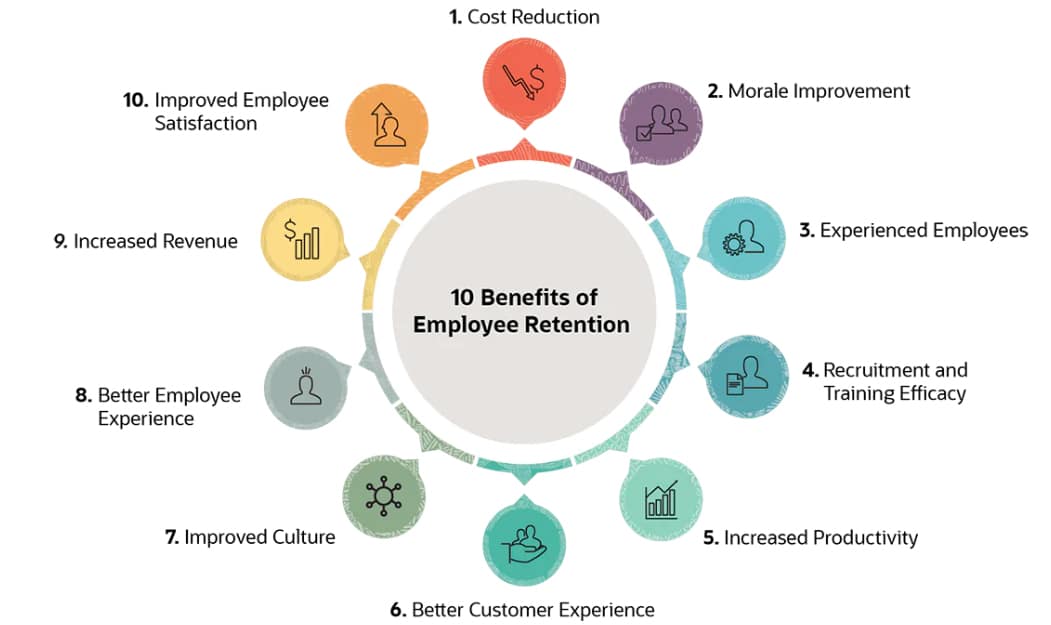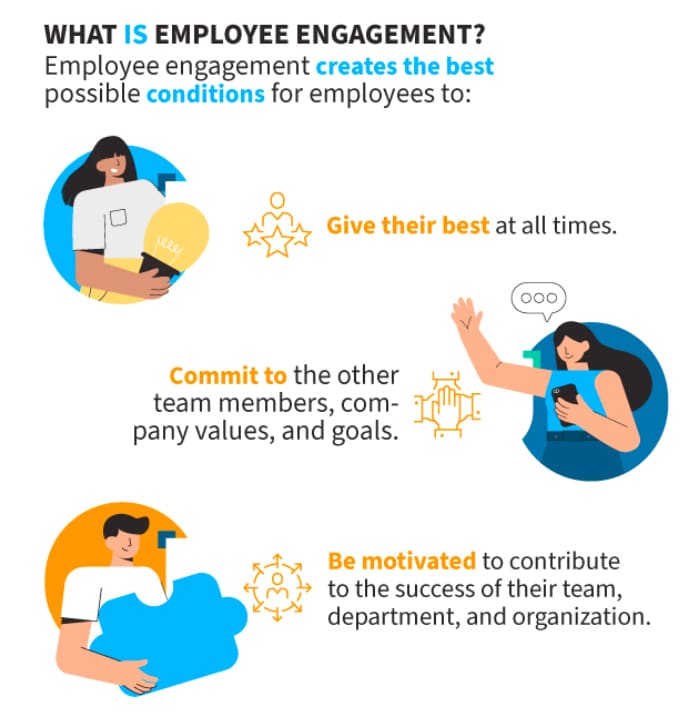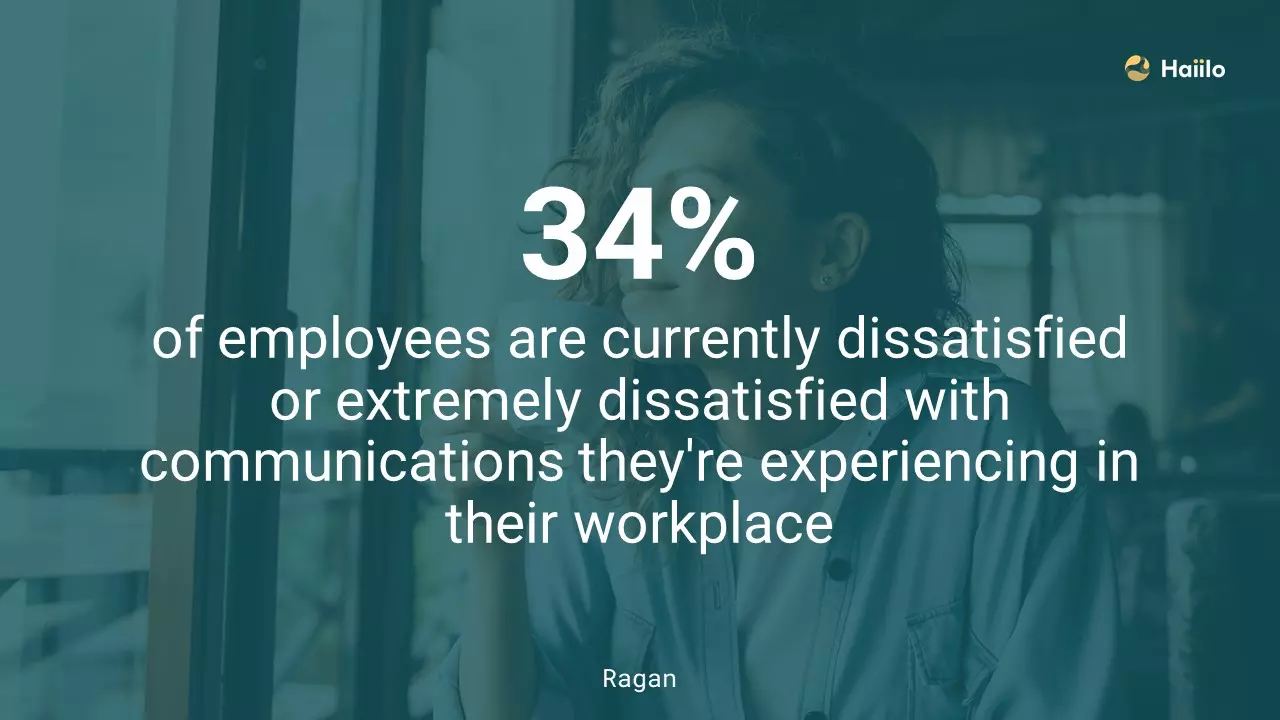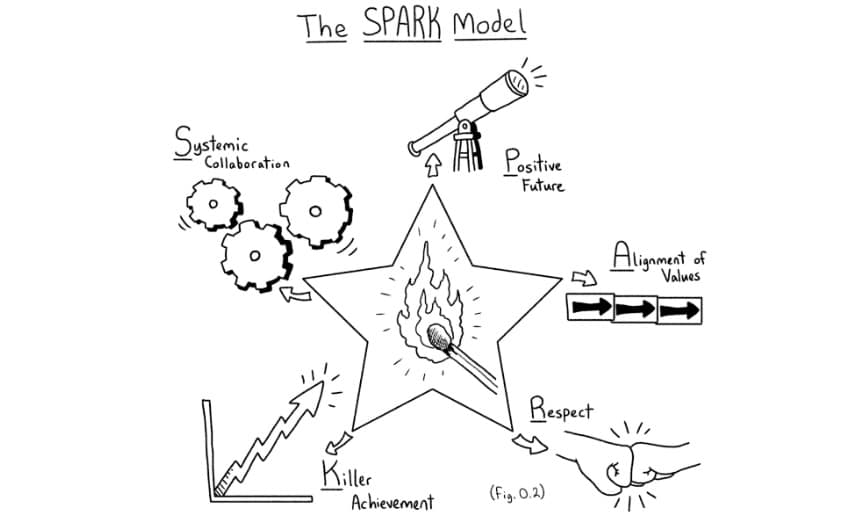Employee Engagement and Retention: 9 Ways To Build Community and Trust
Engaged employees move your business forward. When we feel connected to our work and understand how we positively impact the company’s mission, it makes us feel good. When employee satisfaction is high, turnover rates are low.
Many employers think that compensation or extra work benefits are the most effective retention strategies. When, actually, people prefer to work for organizations that respect and share their values.
Keeping employees engaged and happy at work comes down to creating one main feeling: a sense of belonging. If you can do that, you’ll hold onto your top talent a lot more easily. So, here are 9 ways to build community and trust within your team:
- Encourage open communication
- Co-create your company culture with employees
- Focus on initiatives that make people love their workplace
- Create inclusive onboarding for new hires
- Ask for employee experience feedback regularly
- Align individual goals with the company’s
- Recognize and celebrate all achievements
- Ensure a fair work-life balance
- Build DEIB into your workplace culture
Why Is Employee Retention Important?
Losing an employee can cost a company around 1.5-2 times of the employee’s salary. In 2022, voluntary turnover for US employees is expected to jump nearly 20% (from a pre-pandemic annual average of 31.9 million to 37.4 million.)
High employee turnover doesn’t only waste money; it also impacts your team’s time and productivity. You’re looking at hits from:
-
- Recruitment – from advertising costs to screening and interviewing
- Onboarding process – training, HR costs, and time spent managing
- Productivity – a new employee won’t reach the same productivity levels immediately (even if they’re skilled)
- Errors and experience – new hires with less experience tend to make more errors
- Culture – morale may decrease as co-workers question why a team member has left and have their workload increased
Aside from cost reduction, some of the benefits of employee retention are:
- Providing a better customer experience (CX)
- Growing a reputation for holding onto talent
- Recruitment and training efficacy
- Improved employee satisfaction

Clearly, it’s beneficial for everyone. So, how can you keep your organization’s retention rates high and discourage absenteeism?
What Does Employee Engagement Look Like?
For starters, what is employee engagement? Well, it’s a psychological state that constantly fluctuates depending on multiple physical and mental factors. This could be your working environment, feelings toward leadership, or personal life circumstances.

When employees are engaged, they are:
- Committed to your business and connected to the mission
- Motivated to help it succeed
- More creative and innovative
- Willing to put in extra effort
Low engagement and disengagement cost the world $7.8 trillion in lost productivity—equal to 11% of global GDP. So, how do you ensure your workforce isn’t contributing to that figure?
9 Ways To Help Employees Feel a Sense of Belonging
Your employees need to feel like they belong. It’s a simple concept, but it will take a lot of time and effort to get it right. However, it’ll pay off. Employees with a high sense of belonging are 10x more likely to be satisfied with their jobs and over twice as engaged at work.
Gallup summarized it brilliantly: “Engagement is not a characteristic of employees, but rather an experience created by organizations, managers and team members.”
Here’s how to create that experience.
1. Encourage Open Communication
What’s your current work environment like? Do employees feel they can speak to team leaders about an array of issues without being judged or penalized? It’s up to you to create a supportive social environment. It won’t just happen, and it goes both ways.
Senior management needs to be transparent with ideas, thoughts, and issues too. Communicating this way continuously means there is less chance of surprises and conflicts. It’s also one of the best ways of displaying integrity in the workplace because everyone will feel they can bring their authentic selves every day.
Here’s how you can encourage open communication as a leader:
- Ask for continuous feedback (good or bad)
- Arrange regular one-to-one meetings with those on your team
- Have employees fill in anonymous surveys
- Ensure you’re an active listener

34% of employees are currently dissatisfied or extremely dissatisfied with communications they’re experiencing in the workplace. Make sure yours isn’t part of that figure.
2. Co-Create Your Company Culture With Employees
Many employees think it’s management’s job to create a company’s culture. Perhaps that’s what they’re used to. However, you can be different. It doesn’t matter how established you are; your organization can build a new culture or upgrade your current.
Arrange for all team members to take part in anonymous surveys as a start. Everyone has an opinion, and not having their name attached will make them more likely to share it. Look for recurring patterns and overlaps in what people care about. Then send out more focused versions to get more detail or suggestions.
Dell has topped the list on this year’s Most Loved Workplaces, and a lot of that is down to their culture code:
https://youtu.be/3B4WWnq0Yao
Their core values focus on five areas that they developed with their employees:
- Customers – customer relationships are the foundation for success
- Winning together – they believe in and value teamwork
- Innovation – they cultivate breakthrough thinking for growth and success
- Results – upholding an exceptional standard of excellence and performance
- Integrity – governs their fierce desire to win
The tech giant encourages employees to control their own destiny. As workers use their “build-your-career hub” to skill up, a majority of management jobs are filled internally.
Yours doesn’t have to be as complex as this, but it can be helpful to look at other companies for inspiration.
3. Focus on Initiatives That Make People Love Their Workplace
What makes a Most Loved Workplace? Is it extra perks or benefits? Do you need to have a best friend there to be happy? Not quite. In fact, 78% of employees say they simply want a feeling of value and respect from others they work with.
Employers that promote sustainability and ethical business operations are valued more too. According to Harvard Business Review, studies show employees are willing to give up financial benefits for organizations that practice environmental and corporate social responsibility (CSR).
So, think about it. How else could your workplace better align with the values your employees hold?
Why employees want to be valued and respected is a given. So, here are five other factors that make employees love their workplace:
- People – teamwork and collaboration opportunities
- Ethics – their workplace emphasizes honesty, integrity, and ethics
- Appreciation – recognized for achievements
- Positive future – innovation and a positive attitude are fostered
- Achievements – effort and hard work for the common good are valued
4. Create Inclusive Onboarding for New Hires
Starting at a new company is a nerve-wracking experience for most people, and a lack of confidence can be one of the biggest barriers to employee engagement. Giving new hires an inclusive, welcoming experience can help inspire that sense of belonging early on.
SHRM (strategic human resource management) is meant to help HR bridge the gap between employees and the organization’s strategy and goals. Finding a way to positively impact onboarding could be one of the focuses.

At Google, managers receive a “just in time” email checklist on the Sunday before new employees start. The list involves a few simple steps:
- Discuss roles and responsibilities
- Match the new hire with an onboarding buddy
- Help them build a social network
- Set up onboarding check-ins (once a month for six months)
- Encourage open communication
These ideas are meant to help new hires integrate faster and make connections with their colleagues. Those managers that completed it found team members became fully effective 25% faster than those whose managers’ didn’t.
5. Ask for Employee Experience Feedback Regularly
Employee feedback is so important for reducing high turnover and increasing job satisfaction. Though only if you use the answers to make positive changes.
Sentiment Analysis can be a lot more effective than employee engagement surveys to start exploring the current experience you offer. You could ask to what level your team agrees with statements like:
- I love working for my boss
- I love working with my team members
- I love working for my company
-

Exit interviews can also be insightful—though frustrating as you’ve already lost the employee. However, it doesn’t have to be that way.
Before it gets to that stage, why not organize “stay interviews” with your whole team? By asking questions like “What do you like most about your job?” or “What would you most like to see changed?” you can unearth the important factors that may lead to turnover.
McKinsey believes “companies should explicitly assess belonging in internal surveys.” So, try to collate this data or these metrics and find any overlaps of where and why this feeling isn’t being met. Then create an employee engagement strategy to help fix it.
6. Align Individual Goals With the Company’s
Profitability and your bottom line may be your company’s priority, but your employees need more. There has to be a vision and values that management can inspire everyone to get behind.
You’ll want to do a few things to make this happen:
- Revisit your values every so often to make sure you’re still on track
- Give your employees the resources to perform well
- Let employees suggest ways they can contribute to the overall mission
- Make sure your senior management and team leaders are setting a good example
If you’re doing all of the above, you’re in a better place than most. However, to truly get your employees on board, you need to align their personal goals with the company’s vision. Not only do they need the resources to do their jobs; they also need support for personal growth and professional development.

Ask each employee what their goals are and help them create actionable plans to work towards development opportunities. This will involve organizing one-to-one meetings to connect with each person and understand their motivations. It’ll take time to do this, but creating a more engaged workforce that feels valued and respected is worth it.
7. Recognize and Celebrate All Achievements
Most organizations are quick to criticize workers when things go wrong (we’ve all likely been on the receiving end of this.) Doing this too often will easily demoralize your team and could make them reconsider working for you. Recognizing little wins and achievements takes very little effort but can help employees feel a lot more valued and keen to stick around.
This strategy works for both individuals and full teams and can help everyone feel included. Here are a few ways to recognize and celebrate success:
- Hold a meeting just to say thank you
- Impromptu time off
- Breakfast treats
- Let your employees choose their reward
- Plan a team-building activity
It’s good practice to call out and celebrate small wins regularly. Not enough businesses do. So, tell your managers to start prioritizing employee recognition and try to reward your team wherever possible. It doesn’t have to cost much (or anything). A handwritten note or shout-out on social media can be all it takes.
8. Ensure a Fair Work-Life Balance
These days, people value time just as much as financial perks. For starters, you could encourage your team leaders to focus on productivity rather than hours.
81% of 3,500 employees in a recent poll placed importance and value on flexible working. Offering this or remote work opportunities makes it clear you trust them to manage their own time. It can also help employees with other commitments, like families that need to work around childcare or school pick-ups and drop-offs.

Introducing a flexible time-off policy for vacations could also allow employees from all backgrounds to enjoy events and celebrations that fall at different times of the year. This is another way of ensuring you’re practicing diversity in the workplace.
You should always encourage employees to prioritize their physical and mental health. You may want to place specific focuses on wellness, such as making it mandatory to turn off email notifications after hours or take scheduled breaks. For example, Bumble’s CEO gave all employees an extra week off in 2021 due to pandemic-induced burnout—people can’t bring their most engaged selves to work if they’re run down.
9. Build DEIB Into Your Workplace Culture
DEIB stands for diversity, equity, inclusion, and belonging. Developing into a company that prioritizes these practices is a surefire way to build community and trust within the workforce. That way, you’re creating a work environment where everyone feels included, heard, and offered the same opportunities.
DEIB starts long before hiring takes place and includes everyone, from your most junior members to senior management. We’ve covered some best practices throughout this article and in a more in-depth blog post, but here are some ideas:
- Encourage employee resource groups (ERG)
- Promote diversity in your job application process
- Conduct pay equity reviews
- Forget one-size-fits-all uniform
- Train and engage all employees and management on DEIB
A leadership team that’s willing to commit to building a more diverse, inclusive workforce will likely see a more engaged, productive one. Just make sure any training or sessions are thoughtfully designed. You won’t be able to “fix” things like unconscious bias, but you can make everyone aware of its existence. That’s a step in the right direction.
Final Word
Cultures with high employee engagement and retention are hard to replicate. That’s what makes them so valuable. There will always be members of your team who are more motivated than others, but it’s your job to make everyone feel valued enough to reach that level.
Sometimes, it’s as simple as opening your ears and listening to what’s already being said. Constructive criticism can be an amazing opportunity to grow and transform your organization into one where top talent is competing for a place. You just have to be willing to make real, meaningful changes once you’re aware of the areas you could improve.
Need more ideas for employee engagement and retention? LinkedIn’s blog has lots of great ideas for keeping employees happy and engaged at work.

Louis Carter is the founder and CEO of Best Practice Institute, Most Loved Workplace, and Results-Based Culture. Author of In Great Company, Change Champions Field Guide, and Best Practices in Talent Management, as well as a series of Leadership Development books. He is a trusted strategic advisor and coach to CEOs, CHROs, and leaders of mid-sized to F500 companies – enabling change and steering employer brand development together with highly effective teams, leaders, and organizations as a whole.

0 Comments